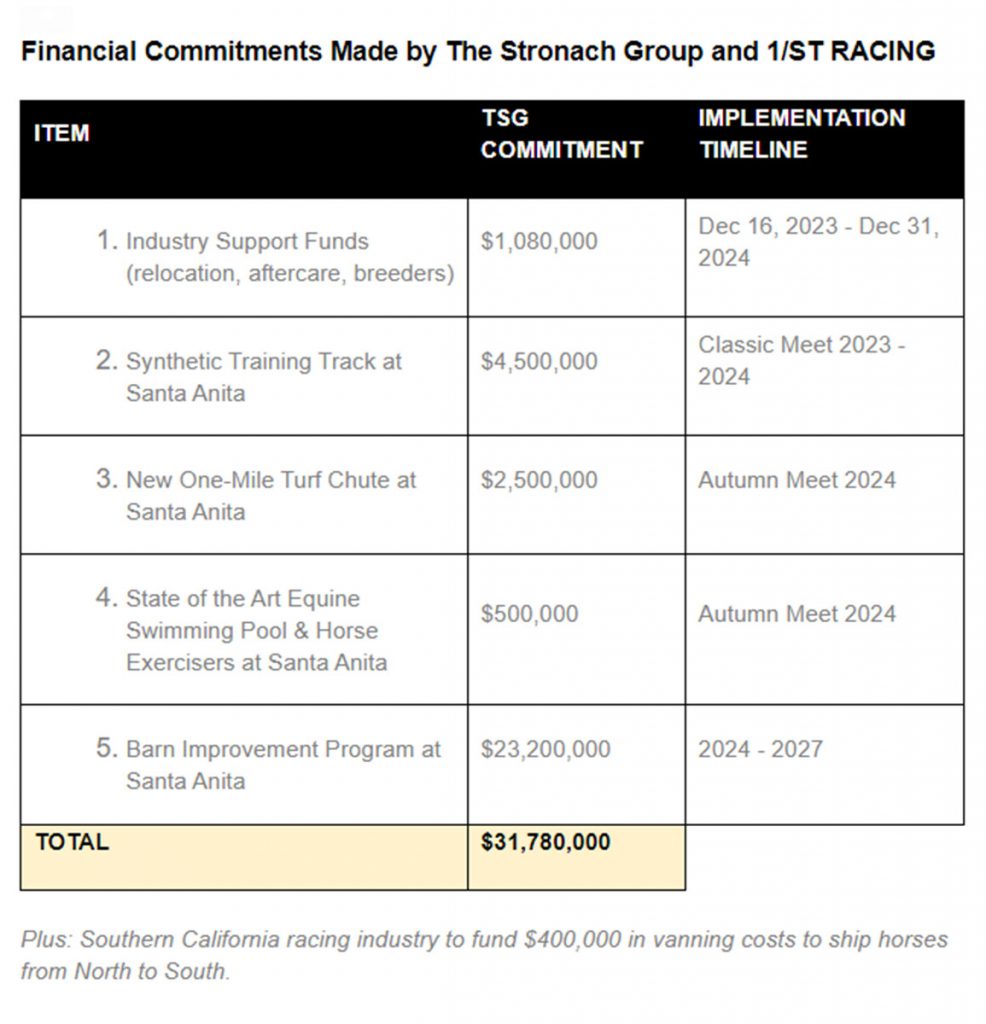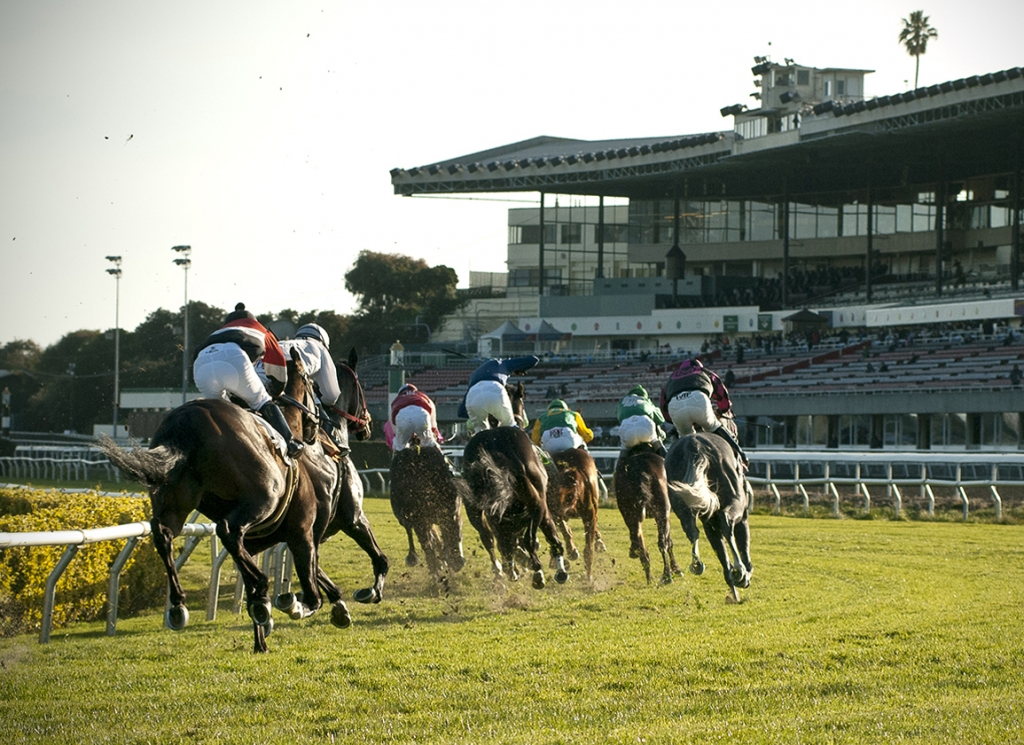Two weeks after an initial company announcement on the closure of Golden Gate Fields at the end of the year, The Stronach Group (TSG) issued details Friday on their plans for consolidating racing operations at its Southern California racing and training facilities, Santa Anita and San Luis Rey Downs.
The plan–shared via Zoom during a press briefing lasting about 30 minutes–appeared large on big-ticket promises though short on specifics in other key areas, including the broader industry impacts from the closure of Golden Gate Fields.
The following details were divulged in the form of a press release:
- Over $1 million to support the relocation of horses, trainers, jockeys, backstretch employees and caregivers from Golden Gate Fields to Santa Anita Park as part of the consolidation of racing in Southern California, and to support the California breeding program.
- A $4.5 million, brand-new all-weather synthetic track that will replace the existing training track at Santa Anita Park. This change will not only allow for the seamless transition of horses used to running on the synthetic track at Golden Gate Fields but will serve to improve the overall safety environment at Santa Anita Park.
- A commitment to fund a portion of 2024 heath care premiums for Golden Gate Field employees.
- The creation of a job board accessible to backside employees to support the transition to Santa Anita Park.
- An investment of $500,000+ (over two years) toward building a state-of-the-art equine pool for hydrotherapy and horse exerciser, accessible to trainers at Santa Anita Park, that will help horses more easily recover from injury.
- $23.2 million toward a backside barn improvement program.
- In addition to returning a fourth day of weekly racing to Santa Anita Park resulting in 26 extra race days, 1/ST RACING will invest $2.5 million into building a turf chute at the track.
During the course of the press conference, CEO of 1/ST Racing and Gaming Aidan Butler and Craig Fravel, executive vice-chairman of 1/ST Racing and Gaming, expanded upon some of these details.
The biggest ticket item concerns the $23 million toward backstretch improvements. “The initial piece of work is to replace every single roof and outer extremity of the barns,” said Butler.
“This is a huge undertaking. We have 2,000 stalls on the backside of Santa Anita. To quickly carve into that answer, there's not a lot of room at Santa Anita to add extra stalls. But the job when completed should have a very modern-looking and -feeling backside.
“The larger plan which we'll touch upon at a different time is that we have future proofed what would happen if we needed more stalls. Some would argue that's a great problem to have. We do have quite a few answers for that, but nothing that would be wise to announce today,” said Butler.
When asked to expand upon what he meant by cutting edge, Butler described it as an overarching theme, meaning “we're going to try to be best in class and cutting edge in everything we do.”
TSG aims to begin work on the synthetic replacement to the training track at the end of the fall meet in November. “The hope…would be to get this ready and operational by opening day,” said Butler.
The new one-turn turf chute at Santa Anita would start in the north parking lot, said Butler, who explained that the idea sprung from the growing inventory of turf horses in Southern California.
“We appreciate and understand that the ecosystem currently in California is quite turf heavy from a racehorse perspective, so, adding new turf options and turf distances and starts is going to be hugely beneficial,” said Butler.
As to the economics behind these proposals, Fravel appeared to leave the door open to the possibility that proceeds from simulcasting handle in Northern California could be diverted south.
“We will be meeting with other stakeholders and looking at gaps in the calendar and looking at how we can reconfigure the economics of California racing,” said Fravel.
In its initial statement, TSG explained that a key “goal” of the consolidation was to increase field sizes at Santa Anita and add “another day of racing to the weekly racing calendar at Santa Anita Park, come January 2024.”
When asked how long Santa Anita could remain financially viable if that extra day of racing doesn't materialize, both Fravel and Butler described the proposed investments as spurs of economic activity.
“I think with an influx of horses from the north, along with the positive impact these changes would have, we have a very realistic chance of making that happen,” said Fravel, who said contingency plans were in place in case the four-day race week didn't materialize, but declined to say what they were.
In answer to concerns that the horses in Northern California will become swamped in the Southern California circuit at the entry box, Butler discussed bringing staff from Golden Gate Fields to help smooth the acclimatization process.
“I think the intent over time is that it will become one population,” said Butler. “We've had some experience in other parts of the country where we can, during bigger meets, run higher quality from a purse perspective, and then middle tier racing on the same card.”
Butler added: “There is another Thursday. Really the intent is to not completely load that day up with horses from Golden Gate, but to mix them across the whole four days' racing.”
In tune with Butler's comments, Fravel discussed the possibility for the “creative” carding of races with an expanded horse population.
“We fully expect that we'll be able to write condition books, racing conditions, be creative in terms of making sure that, not only the current population at Golden Gate has a place to run, but also that we'll be able to support additional racing hopefully at Los Alamitos,” Fravel said.
In terms of a totally reconstituted Southern California racing product, Butler raised the possibility of additional 'Ship & Win' incentives.
“There are lots of plans in the works to not only attract international runners, but keep up the good work that's been done,” said Butler.
As for the Golden Gate diaspora, the number of trainers and horses that can be accommodated at Santa Anita and San Luis Rey Downs is limited, admitted Butler–a restriction dictated by limited stall space in Southern California, he added.
“We're going to give every trainer and every horse as much as we can to get down here,” said Butler, pointing to the proposed industry support fund.
“Not only a stipend per horse that comes down, but also stipends for jockeys to try to integrate down in the south. There is a separate piece that covers the trainers themselves, humans as they're moving around, and their employees,” Butler added.
After the meeting concluded, TDN asked if the relocation funds would also be used to help those trainers, backstretch staff and horses who are unable to relocate south to Santa Anita or San Luis Rey Downs.
“Yes, if there is any left,” wrote a TSG spokesperson.
One enormous question stemming from TSG's plans is how the closure of Golden Gate Fields will impact the state breeding industry, which has been contracting for years.
As a sign of just how integral Cal-breds remain to the state racing product, however, during Santa Anita's recently concluded six-month meet, Cal-breds made up about 37% of all individual starts, according to DRF chart data. Cal-bred races constituted more than 20% of the overall races.
At Golden Gate Fields, Cal-breds made up nearly 70% of all starts last year, according to DRF chart data–a number that had grown from 60% of all starts at the track in 2013.
TSG has proposed hosting the annual Cal-bred sale at Santa Anita. When asked if TSG has run the numbers on the impacts on the state breeding industry from the closure of Golden Gate fields, Fravel admitted the company had not made such calculations, but pointed toward the additional funds earmarked for the breeding industry.
“We have had breeders who have said to us they're very encouraged with the prospects for Santa Anita, and increased purse money that should be available to them,” said Fravel.
“We're going to sit down with the leadership of the CTBA [California Thoroughbred Breeders Association]. They have some ideas in terms of how they can promote additional breeding, and support the existing program,” Fravel added.
In Friday's press releases, TSG wove in remarks from the Thoroughbred Owners of California (TOC) and from prominent California breeder Terry Lovingier.
“While we continue to work diligently on what the north might look like in 2024, today's announcement answers important short-term questions about the future of California racing and Santa Anita Park,” said Bill Nader, TOC president and CEO. “This represents both an investment and a commitment by Belinda Stronach and her team to not only stabilize but likely improve California racing for stakeholders, horsemen/women, backstretch workers and the betting public. These initiatives will provide a much better environment for our horses and make our overall racing stronger for the immediate future.”
“With these renovations and the commitment to California-bred racing, I see the opportunities for Cal-breds greatly increasing and providing more value for those horses because of it. I'm going to breed more mares to take advantage of it. This is going to benefit the entire industry in the state,” said Lovingier.
“We're a racing company,” said Fravel during Friday's press conference. “We love racing, and we want it to succeed. Hopefully the breeders will share that optimism with us.”
“We are confident that this comprehensive package of important measures will not only bolster the racing, training, owner and fan experience at Santa Anita Park, 'The Great Race Place', but also support Northern California stakeholders through a challenging transition period, and lead the way with state and industrywide changes that will result in a healthier, competitive and sustainable future for Thoroughbred racing in Southern California,” said Belinda Stronach, TSG chairwoman, CEO and president.
On Thursday, news broke that Stronach has been in talks over the last year to become an investor in the Sacramento Republic Football Club.
The post Stronach Group Outlines Plans for Southern California appeared first on TDN | Thoroughbred Daily News | Horse Racing News, Results and Video | Thoroughbred Breeding and Auctions.



